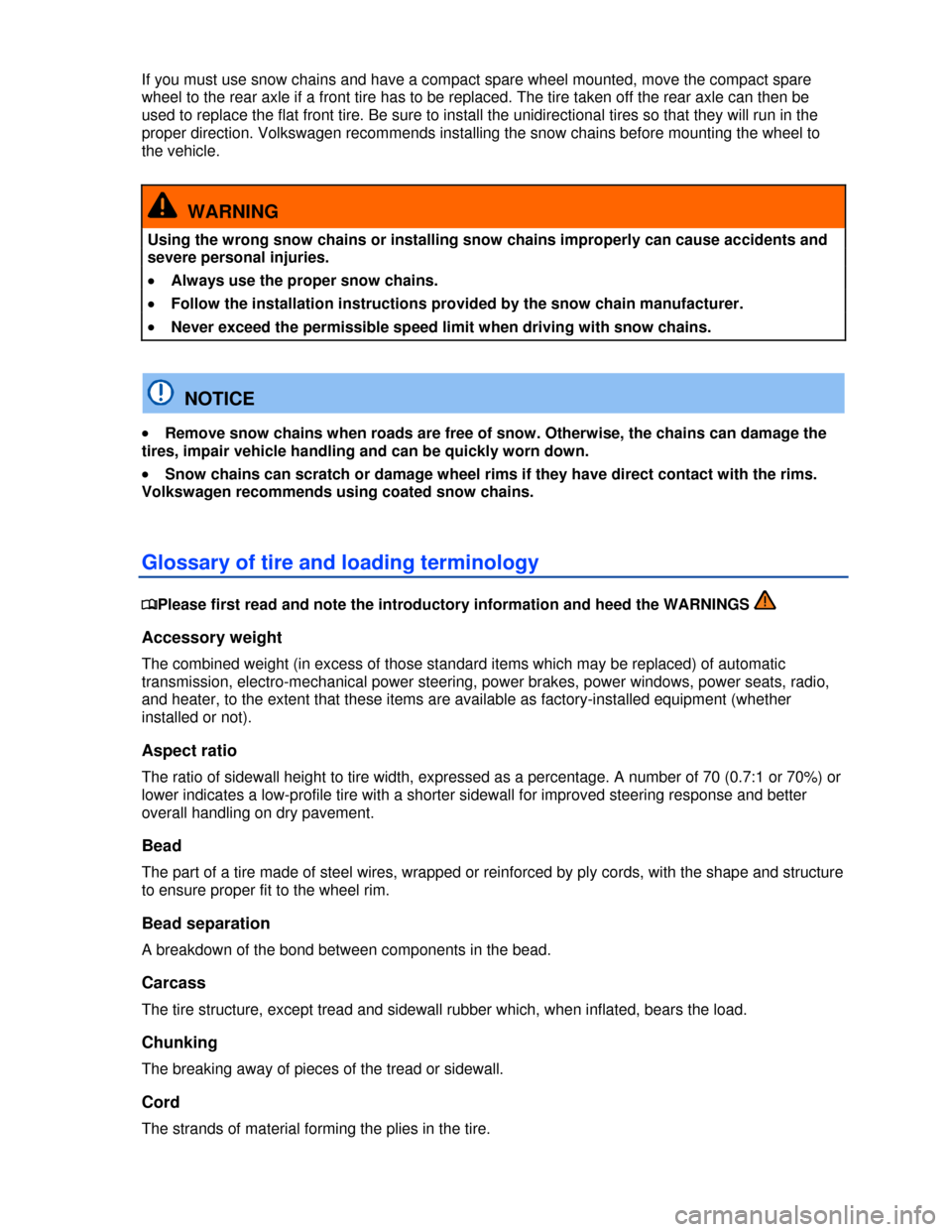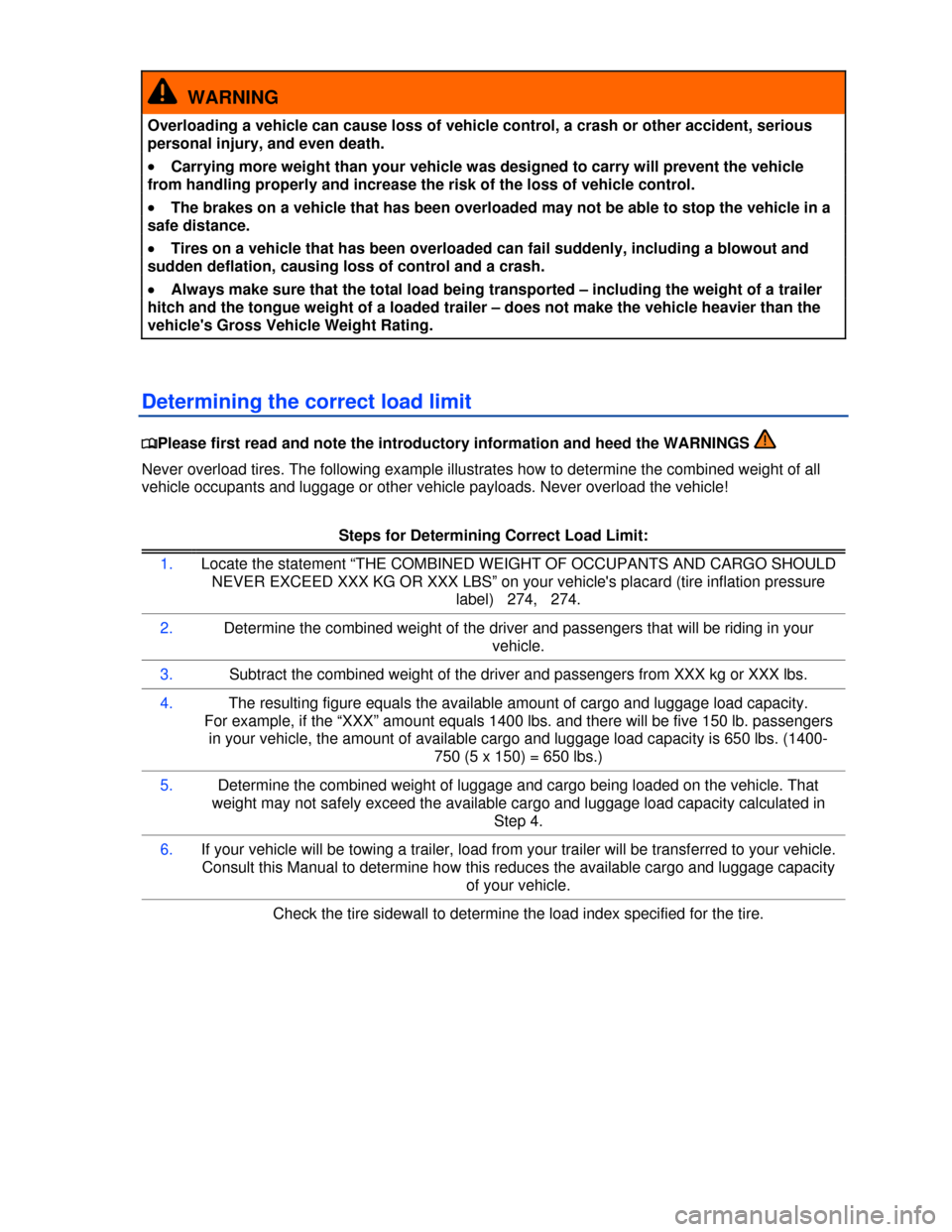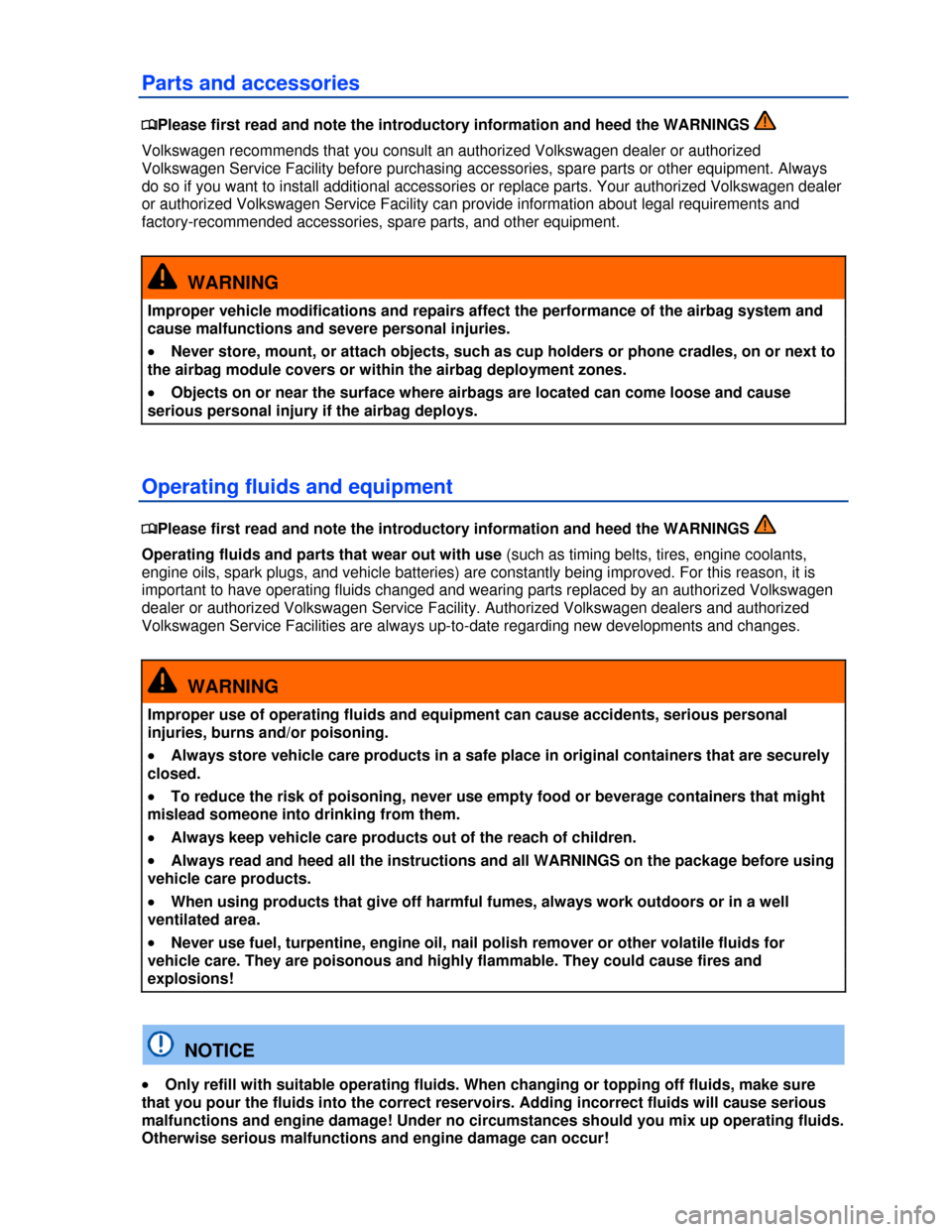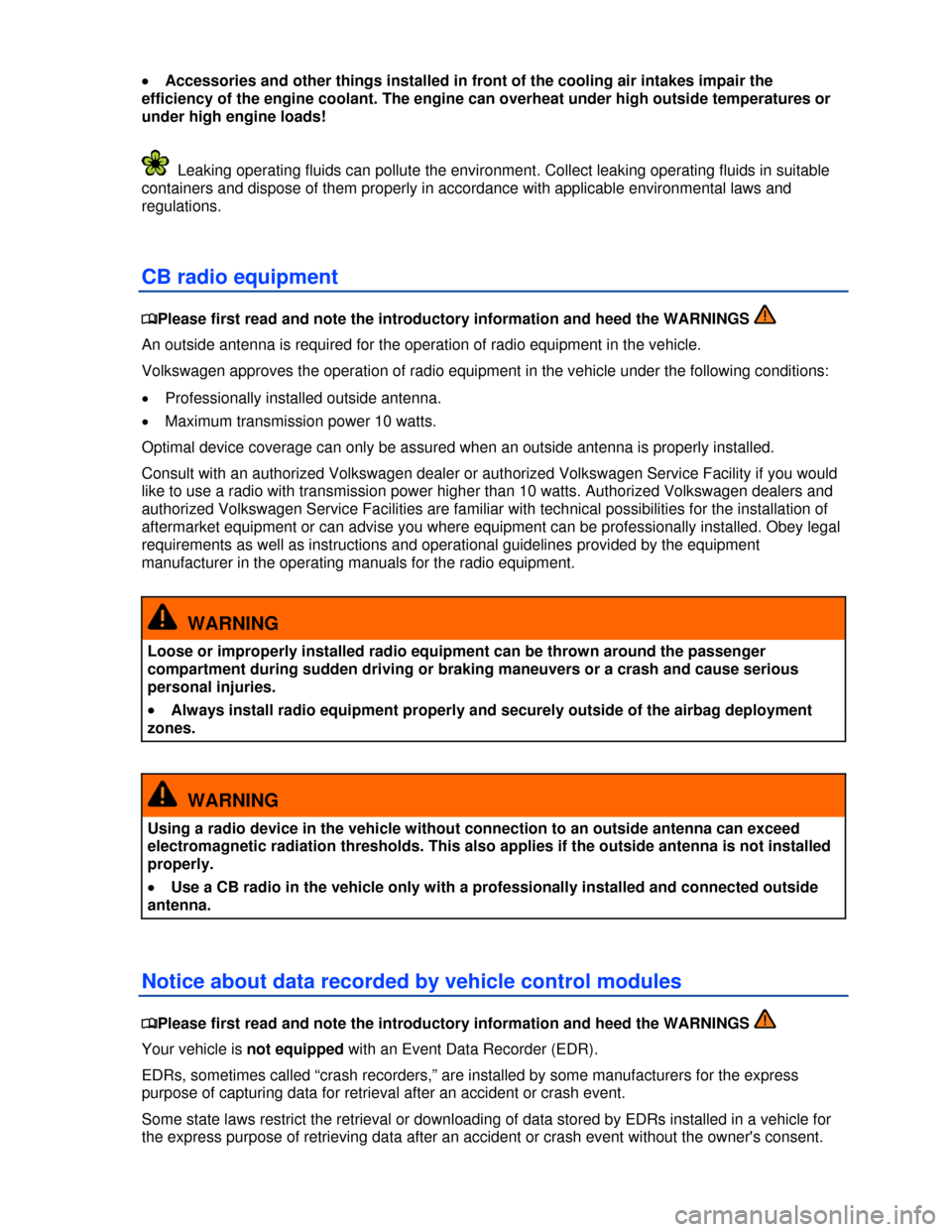VOLKSWAGEN PASSAT CC 2013 1.G Owners Manual
Manufacturer: VOLKSWAGEN, Model Year: 2013, Model line: PASSAT CC, Model: VOLKSWAGEN PASSAT CC 2013 1.GPages: 353, PDF Size: 5.56 MB
Page 291 of 353

If you must use snow chains and have a compact spare wheel mounted, move the compact spare
wheel to the rear axle if a front tire has to be replaced. The tire taken off the rear axle can then be
used to replace the flat front tire. Be sure to install the unidirectional tires so that they will run in the
proper direction. Volkswagen recommends installing the snow chains before mounting the wheel to
the vehicle.
WARNING
Using the wrong snow chains or installing snow chains improperly can cause accidents and
severe personal injuries.
�x Always use the proper snow chains.
�x Follow the installation instructions provided by the snow chain manufacturer.
�x Never exceed the permissible speed limit when driving with snow chains.
NOTICE
�x Remove snow chains when roads are free of snow. Otherwise, the chains can damage the
tires, impair vehicle handling and can be quickly worn down.
�x Snow chains can scratch or damage wheel rims if they have direct contact with the rims.
Volkswagen recommends using coated snow chains.
Glossary of tire and loading terminology
�
Page 292 of 353

Cord separation
The parting of cords from adjacent rubber compounds.
Cracking
Any parting within the tread, sidewall, or inner liner of the tire extending to cord material.
Cold tire inflation pressure
The tire pressure recommended by the vehicle manufacturer for a tire of a specified size that has not
been driven for more than a couple of miles (kilometers) at low speeds in the 3 hour period before the
tire pressure is measured or adjusted.
Curb weight
The weight of a motor vehicle with standard equipment including the maximum capacity of fuel, oil,
and coolant, air conditioner, and additional weight of optional equipment.
Extra load tire
A tire designed to operate at higher loads and at higher inflation pressures than the corresponding
standard tire.
Gross Axle Weight Rating (GAWR)
The load-carrying capacity of a single axle system, measured where the tire contacts the ground.
Gross Vehicle Weight Rating (GVWR)
The maximum loaded weight of the vehicle.
Groove
The space between 2 adjacent tread ribs.
Load rating (code)
The maximum load that a tire is rated to carry for a given inflation pressure. You may not find this
information on all tires because it is not required by law.
Maximum load rating
The load rating for a tire at the maximum permissible inflation pressure for that tire.
Maximum loaded vehicle weight
The total of:
�x Curb weight.
�x Accessory weight.
�x Vehicle capacity weight.
�x Production options weight.
Maximum (permissible) inflation pressure
The maximum cold inflation pressure to which a tire may be inflated. Also called “maximum inflation
pressure.”
Normal occupant weight
Means 150 lbs (68 kilograms) times the number of occupants seated in the vehicle up to the total
seating capacity of your vehicle.
Occupant distribution
The placement of passengers in a vehicle.
Page 293 of 353

Outer diameter
The diameter of a new, properly inflated tire.
Overall width
Total width measured at the exterior sidewalls of an inflated tire, including the additional width of
labeling, decorations, or protective bands or ribs.
Passenger car tire
A tire intended for use on passenger cars, multipurpose passenger vehicles, and trucks, that have a
gross vehicle weight rating (GVWR) of 10,000 pounds or less.
Ply
A layer of rubber-coated parallel cords.
Ply separation
A parting of rubber compound between adjacent plies.
Pneumatic tire
A mechanical device made of rubber, chemicals, fabric, and steel or other materials, that, when
mounted on an automotive wheel, provides the traction and contains the gas or fluid that sustains the
load.
Production options weight
The combined weight of installed regular production options weighing over 5 lbs (2.3 kg) more then the
standard items they replace, and not previously considered as curb weight or accessory weight. These
include, for example, heavy-duty brakes, ride levelers, roof rack, heavy-duty battery, and special trim.
Radial ply tires
A pneumatic tire in which the ply cords that extend to the beads are laid at substantially 90 degrees to
the centerline of the tread.
Recommended inflation pressure
The tire pressure recommended by the vehicle manufacturer for a tire of a specified size that has not
been driven for more than a couple of miles (kilometers) at low speeds in the 3 hour period before the
tire pressure is measured or adjusted.
Reinforced tire
A tire designed to operate at higher loads and at higher inflation pressures than the corresponding
standard tire.
Rim
The outer edge of a wheel upon which the tire beads are seated.
Rim diameter
The nominal diameter of the wheel's tire bead seating surface. If you change your wheel size, to
wheels of a different diameter, you will have to purchase new tires to match the new wheels.
Rim size
Designation means rim diameter and width.
Rim type designation
The industry or manufacturer's designation for a rim by style or code.
Rim width
The nominal distance between wheel rim flanges.
Page 294 of 353

Section width
The linear distance between the exteriors of the sidewalls of an inflated tire, excluding elevations due
to labeling decoration, or protective bands.
Sidewall
The portion of a tire between the bead and the tread.
Sidewall separation
The parting of the rubber compound from the cord material in the sidewall.
Speed rating (letter code)
A standardized letter code indicating the maximum speed at which a tire is designed to be driven for
extended periods of time. The ratings range from 93 mph or 150 km/h (“P”) to 186 mph or (300 km/h)
“Y”.
The speed rating letter code, where applicable, is molded on the tire sidewall , Tire labeling. You may
not find this information on all tires because it is not required by law.
Tire Pressure Monitoring System
A system that detects when at least one of a vehicle's tires is underinflated and illuminates a low tire-
pressure warning light.
Tread
The portion of a tire that normally touches the road.
Tread rib
A tread section running circumferentially around a tire.
Tread separation
Tire failure caused by the tread pulling away from the tire carcass.
Tread wear indicators (TWI)
Raised areas within the main tread grooves that show, visually, when tires are worn and near the end
of their useful life 278, Tread depth and tread wear indicators.
Uniform Tire Quality Grading (UTQG)
A tire information system developed by the U.S. National Highway Traffic Safety Administration
(NHTSA) that is designed to help buyers compare tires. UTQG is not a safety rating, nor is it a
guarantee that a tire will last for a certain number of miles or perform a certain way. It gives tire buyers
more information to compare with factors such as price, brand loyalty and dealer recommendations.
Under UTQG, tires are graded by the tire manufacturers in 3 areas: tread wear, traction and
temperature resistance. UTQG information is molded into the tire sidewalls.
U.S. DOT Tire Identification Number (TIN)
A tire's serial number. It begins with the letters “DOT” (“Department of Transportation”) and indicates
that the tire meets all federal standards. The next 2 numbers or letters indicate the plant where the tire
was manufactured. The last 4 numbers represent the week and year of manufacture.
For example, the numbers 1709 mean that the tire was produced in the 17th week of 2009. Any other
numbers are marketing codes used by the tire manufacturer. This information is used to help identify
affected consumers if a tire defect requires a recall.
Vehicle capacity weight
The total rated cargo, luggage and passenger load. Passenger load is 150 lbs (68 kilograms) times the
vehicle's total seating capacity (as listed on the label inside the driver door).
Page 295 of 353

Vehicle maximum load on the tire
The load on an individual tire that is determined by taking each axle's share of the maximum loaded
vehicle weight (GAWR) and dividing by 2.
Vehicle normal load on the tire
The load on an individual tire that is determined by taking each axle's share of the curb weight,
accessory weight, and normal occupant weight (distributed according to the table below) and dividing
by 2.
Wheel size designation
Wheel rim diameter and width.
Occupant loading and distribution for vehicle normal load for various designated seating
capacities
Designated seating capacity,
number of occupants
Vehicle normal load, number
of occupants
Occupant distribution in a
normally loaded vehicle
2, 3, or 4 2 2 in front
5 3 2 in front, 1 in back
Tires and vehicle load limits
�
Page 296 of 353

WARNING
Overloading a vehicle can cause loss of vehicle control, a crash or other accident, serious
personal injury, and even death.
�x Carrying more weight than your vehicle was designed to carry will prevent the vehicle
from handling properly and increase the risk of the loss of vehicle control.
�x The brakes on a vehicle that has been overloaded may not be able to stop the vehicle in a
safe distance.
�x Tires on a vehicle that has been overloaded can fail suddenly, including a blowout and
sudden deflation, causing loss of control and a crash.
�x Always make sure that the total load being transported – including the weight of a trailer
hitch and the tongue weight of a loaded trailer – does not make the vehicle heavier than the
vehicle's Gross Vehicle Weight Rating.
Determining the correct load limit
�
Page 297 of 353

Parts, accessories, repairs and modifications
�
Page 298 of 353

WARNING
Inappropriate spare parts and accessories as well as improperly performed work,
modifications and repairs can cause vehicle damage, accidents and serious personal
injuries.
�x Volkswagen strongly recommends to only use accessories approved by Volkswagen and
Genuine Volkswagen Parts®. These parts and accessories have been evaluated by
Volkswagen for their suitability, reliability and safety.
�x Have repairs and vehicle modifications performed by an authorized Volkswagen dealer or
authorized Volkswagen Service Facility. Authorized Volkswagen dealers and authorized
Volkswagen Service Facilities have the required tools, diagnostic equipment, repair
information, and trained personnel to properly replace any airbag in your vehicle and assure
system effectiveness in a crash.
�x Only install parts on the vehicle that are consistent with factory-installed parts with
respect to design and characteristics.
�x Never store, mount, or attach objects, such as cup holders or phone cradles, on or next to
the airbag module covers or within the airbags deployment zones.
�x Only use wheel rim/tire combinations approved by Volkswagen for the respective vehicle
type.
Break-in period
�
Page 299 of 353

Parts and accessories
�
Page 300 of 353

�x Accessories and other things installed in front of the cooling air intakes impair the
efficiency of the engine coolant. The engine can overheat under high outside temperatures or
under high engine loads!
Leaking operating fluids can pollute the environment. Collect leaking operating fluids in suitable
containers and dispose of them properly in accordance with applicable environmental laws and
regulations.
CB radio equipment
�